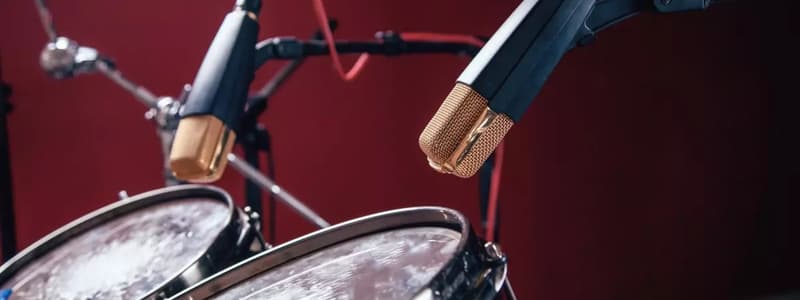Podcast
Questions and Answers
Why did the engineer find it difficult to control the snare in the DAW session?
Why did the engineer find it difficult to control the snare in the DAW session?
- The snare was too loud in the mix
- The engineer lacked the necessary skills to control the snare
- The DAW session had limited faders for adjusting the snare
- The snare was routed to multiple auxiliary channels and various buses for processing (correct)
What did the engineer do to try and resolve the issue with the snare?
What did the engineer do to try and resolve the issue with the snare?
- Increased the number of channels in the DAW
- Lowered the main drum bus fader (correct)
- Unpicked and rebuilt the drum mix
- Brought up the level of the rest of the kit
What did the engineer find easy to adjust in the DAW session?
What did the engineer find easy to adjust in the DAW session?
- The kick drum level
- The snare level
- The routing options for processing
- The main drum bus fader (correct)
What does the text suggest about the downside of using a DAW for mixing?
What does the text suggest about the downside of using a DAW for mixing?
Why did the engineer find it inefficient to adjust the snare in the DAW session?
Why did the engineer find it inefficient to adjust the snare in the DAW session?
What is the purpose of creating subgroups for multi-miked kit pieces like kick, snare, and toms?
What is the purpose of creating subgroups for multi-miked kit pieces like kick, snare, and toms?
What is the function of the Rooms/Effects group in the author's approach to managing routing for multitrack drums?
What is the function of the Rooms/Effects group in the author's approach to managing routing for multitrack drums?
What is the role of parallel processing in the author's approach to managing routing for multitrack drums?
What is the role of parallel processing in the author's approach to managing routing for multitrack drums?
Why does the author recommend processing the drum sound at the highest level possible before getting into details?
Why does the author recommend processing the drum sound at the highest level possible before getting into details?
What is the initial grouping of drums in the author's approach to managing routing for multitrack drums based on?
What is the initial grouping of drums in the author's approach to managing routing for multitrack drums based on?
What is the main idea the author wants you to take away from the passage?
What is the main idea the author wants you to take away from the passage?
What does the author compare audio signal flow to?
What does the author compare audio signal flow to?
According to the passage, what happens if you mute the drum bus?
According to the passage, what happens if you mute the drum bus?
What does the author encourage readers to consider regarding their approach?
What does the author encourage readers to consider regarding their approach?
What benefit does the author highlight about working 'upstream' in audio signal flow?
What benefit does the author highlight about working 'upstream' in audio signal flow?
Flashcards are hidden until you start studying
Study Notes
- The text discusses the author's approach to managing routing for multitrack drums in a Digital Audio Workstation (DAW)
- The author's setup is simple but allows for control over key components of the drum sound
- At the beginning of a mix, the author groups drums into three stereo buses: Close Mics, Overheads, and Rooms/Effects
- Close Mics group includes focused captures of individual drum elements, such as close kick and snare mics
- Overheads group contains main overheads and cymbal spot mics, used to retain the acoustic quality of the drums
- Rooms/Effects group includes ambience and effect mics, helpful for gauging their influence in the mix
- As the mix progresses, the author creates subgroups for multi-miked kit pieces (kick, snare, and toms) and routes them to the main Close Mics group
- Parallel processing is used for creative experimentation, with dedicated auxiliary channels routed directly to the main drum bus
- Sends from broad groups can be used to feed a different balance into the parallel compressor for quick and effective control
- The author finds that by processing the drum sound at the highest level possible (drum bus), and then getting into details, they can achieve the desired drum sound.
Studying That Suits You
Use AI to generate personalized quizzes and flashcards to suit your learning preferences.



